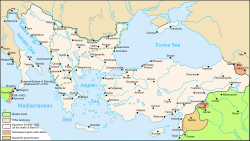Byzantine Empire under the Macedonian dynasty
| Roman Empire | ||||||||||
| Βασιλεία Ῥωμαίων | ||||||||||
|
||||||||||
|
The Byzantine Empire at the death of Basil II, 1025
|
||||||||||
| Capital | Constantinople | |||||||||
| Languages | Medieval Greek, Albanian, Armenian and other South Slavic languages, Syriac, Arabic, Medieval Latin, Romance languages | |||||||||
| Religion | Eastern Orthodox Church | |||||||||
| Government | ||||||||||
| Emperor | ||||||||||
| • | 867–86 | Basil I | ||||||||
| • | 1056–57 | Michael VI | ||||||||
| History | ||||||||||
| • | Murder of Michael III | 2 September 867 | ||||||||
| • | Abdication of Michael VI | 31 August 1057 | ||||||||
|
||||||||||
The medieval Byzantine Empire reached its height under the Macedonian emperors of the late 9th, 10th, and early 11th centuries, when it gained control over the Adriatic Sea, southern Italy, and all of the territory of the Tsar Samuil of Bulgaria.
The cities of the empire expanded, and affluence spread across the provinces because of the new-found security. The population rose, and production increased, stimulating new demand while also helping to encourage trade.
Culturally, there was considerable growth in education and learning (the "Macedonian Renaissance"). Ancient texts were preserved and patiently re-copied. Byzantine art flourished, and brilliant mosaics graced the interiors of the many new churches.
Though the empire was significantly smaller than during the reign of Justinian, it was also stronger, as the remaining territories were less geographically dispersed and more politically and culturally integrated.
Although tradition attributed the "Byzantine Renaissance" to Basil I (867–886), initiator of the Macedonian dynasty, some later scholars have credited the reforms of Basil's predecessor, Michael III (842–867) and of the erudite Theoktistos (died 855). The latter in particular favoured culture at the court, and, with a careful financial policy, steadily increased the gold reserves of the Empire. The rise of the Macedonian dynasty coincided with internal developments which strengthened the religious unity of the empire.
The iconoclast movement experienced a steep decline: this favoured its soft suppression by the emperors and the reconciliation of the religious strife that had drained the imperial resources in the previous centuries. Despite occasional tactical defeats, the administrative, legislative, cultural and economic situation continued to improve under Basil's successors, especially with Romanos I Lekapenos (920–944). The theme system reached its definitive form in this period. The Eastern Orthodox Church establishment began to loyally support the imperial cause, and the state limited the power of the landowning class in favour of agricultural small-holders, who made up an important part of the military force of the Empire. These favourable conditions contributed to the increasing ability of the emperors to wage war against the Arabs.
...
Wikipedia

